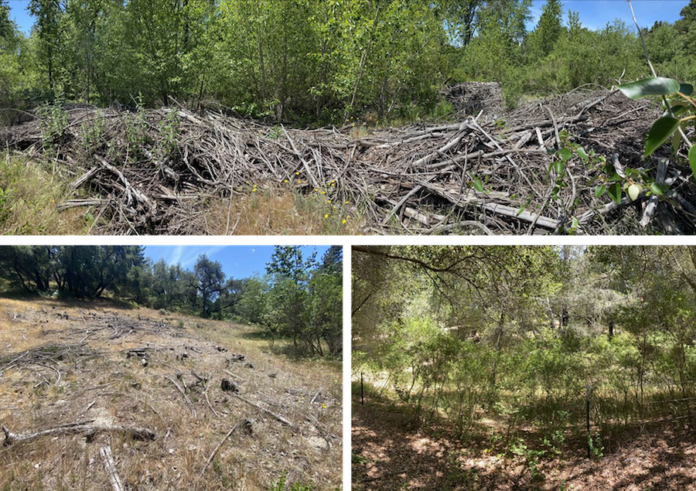In the world of water districts, challenges abound. From fires and floods to earthquakes and droughts, there is a multitude of issues that can affect the safety and security of water sources for the population served.
San Lorenzo Valley Water District (SLVWD) is certainly no exception, and now, the district has teamed with Pacific Gas & Electric Company to help manage another test of the district’s stability: encroaching, non-native plants resulting in a riparian restoration project.
According to Carly Blanchard, Environmental Programs Manager for SLVWD, PG&E was the agency that created momentum—and the opportunity—for this management process. The utility company approached the district in May of 2021 seeking riparian habitat to complete a planting mitigation project.
“The district held a few calls with a consulting ecologist and district staff before a 1.15-acre area of riparian and oak woodland habitat located along an ephemeral tributary to Zayante Creek was selected on the District’s Olympia Watershed property,” said Blanchard, who has been with the district since 2017, when she joined as the water conservation specialist.
Blanchard was promoted to an environmental planner in 2019, and then the environmental programs manager in June of 2021. In that position, Blanchard oversees a multitude of programs for the district, including:
- Facilitates district’s sustainable water supply planning
- Conducts environmental permitting for capital improvement projects
- Conducts legislative review and advocates to protect district resources
- Facilitates public engagement and communication of district activities through an integrated multi-media approach
- Helps identify current or potential drought conditions to help the district increase water conservation guidelines to meet demand and regulatory requirements
- Identifies grant funding opportunities, prepares applications, coordinates with other agencies for collaborative grants and administers grants awarded
- Manages district lands to protect water supply
With all those responsibilities, Blanchard says she was thrilled to team up with PG&E to complete this project.
“This partnership was initiated by PG&E, who originally approached the district seeking conservation credits for protected sand hills species,” Blanchard said. “During these initial conversations, staff discussed other habitat types on district lands, leading to the riparian restoration project.”
Blanchard notes that the process is multi-pronged.
“The project has two pieces of restoration work. First is the ‘riparian mitigation project’ which entails removing invasive plants and acacia tree biomass throughout the 1.15‐acre identified riparian area, then planting riparian trees and understory plants within a 0.29‐acre area and coast live oak within an estimated 0.22‐acre area,” she said. “That process will be followed by installing plants within areas that lack established tree canopy which will accelerate establishment of the native plant community structure and suppress re‐establishment of invasive plants.”
The second restoration project is focused on invasive removal in approximately six acres of the Olympia watershed.
“If you have hiked the property, many of the trails are lined with thick stands of French broom (Genista monspessulana), which the district has worked hard to combat over the years,” she said. “As payment for using the district’s property for PG&E’s riparian mitigation project, invasive removal and maintenance in the Olympia watershed will be paid by PG&E (total project cost roughly $112,000).”
The agreement states, Blanchard says, PG&E will work with ecologist Jodi McGraw to remove invasive species including French broom, Portuguese Broom and Pampas grass in approximately six acres of the Olympia watershed, then maintain these areas for four years after the initial removal.
The project began on Nov. 29 and will be completed in early January 2022. Ongoing invasive removal work will take place annually for four years after the initial project completion, says Blanchard.
“This is an excellent opportunity for restoration at no cost to the district and developing a working relationship with PG&E. Invasive removal work is being completed with hand labor and all biomass will be hauled off-site,” she said.










